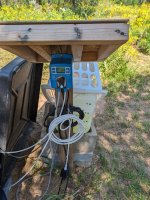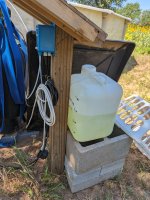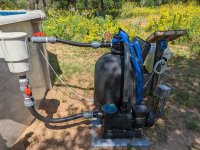Following up on this topic.
I went ahead and bought the Hanna BL101 (link above in my previous post) toward the end of last year's swimming season.
Since it was the end of the season, I just stored it until "next year" (this year). I also bought some of the other goodies I needed/wanted in order to install it. Some Flexible PVC to replace the plastic tubing connecting my AG pool to the equipment. Partly because I had a feeling the tubing was restricting flow, and partly because it was prone to collapsing (the suction side) when some restriction made it into the vacuum, or the strainer. I also installed some ball valves.
Installation of everything was fairly smooth as part of the pool opening, and after a bit of time dialing in the Hanna, I was pretty happy with the result.
Here's a quote from a mail I sent Hanna (why was I sending them mail? We'll get to that

)
I've recently installed the BL101 that I purchased last year (I installed it as part of re-opening my pool), and after a few days to a week of tweaking and fiddling, I got it to where I felt it was running fairly well. Aside from ensuring the tank has chlorine in it for the BL101 to draw from, it's largely "set it and forget it", which is what I was hoping for. My installation consists of a five gallon tank (kind of a 'carboy' style jug) that I have sitting at ground level, the BL101 sitting at about 3.5 - 4 feet above ground, mounted to a pole with a little roof over it to shelter it from afternoon sun and any rain. All the equipment is outside. The injector and the sensor are installed in the return line from machinery to the pool (between the sand filter and the pool to be more precise). I'm using the parts that came with the BL101: the strainer/filter block in the intake jug, the soft 1/4 tubing from the intake jug to the pump, the firm 1/4 tubing from the pump to the injector fitting. The injector fitting and sensor are installed in the provided saddles on the return line. (Sensor about 2 inches in 'front' of the injector - i.e., the water flows past the sensor, and then past the injector.) Both tubing runs are in the 6-8 foot range - the suction-side is probably a bit longer than the pressure side. I leave the pool pump on all the time, as well as the BL101, except brief moments while putting the pool vac in the pool, and things like that. I leave the set point at 685, and it usually maintains a level between 670 and 715 (I see fluctuations which relate to time of day, and I think they're just a result of the changing water temperature, so I'm not too concerned about that).
So, I wrote them that, and more, because there
was a fly in the ointment - I noted that at about that time (six weeks after install, early in the season, so going easy on the chlorine consumption), it started having a problem with "losing it's prime". I wrote to Hanna, explained all my observations and trouble-shooting. They sent me a couple of feebies to see if they addressed the issue: a replacement injector, and a pump tubing kit (two pump tubes, some silicone lubricant). I put on one of the new tubes the very next time I saw an issue, and everything went back to running well.
Still not totally sure if the loss of prime is because the tubing is worn out, or if it's because of excessive out-gassing of the chlorine now that it's getting properly sunny and hot here (>100ºF is normal). The new tubing DOES seem to make it run like clockwork for a time.
So... The bits they sent me were free/goodwill, since I'd just bought it, but normally, that kit with the two tubes is $40-$50. Since they only seem to last 2-6 weeks totally trouble free (based on my limited experience so far), I'm not happy with that cost.
I've spent a bit of time researching tubing. Hanna's is marked VERDERPRENE which I've found online, but not for sale in quantities that I'm keen to buy. Also, it doesn't last long.

I've tried some Tygon 2375 (Ultra Chemical Resistant Tubing), but it's either too big or too stiff. It is slightly bigger (~1/64") but I think this is the closest size match I could get. The real issue is probably the stiffness. Either way, the stepper motor in the pump can't handle it - it just loses steps.
I see that Stenner pumps use Santoprene. Well, some do anyway - I'm really not sure if that's the right material for a chlorine dosing pump. I also see that Stenner's replacement bits are cheaper.

rolleyes:, again).
I think part of the issue is that the Hanna pumphead is quite small. The tubing is only 4" long, and I'd guess the radius is about 1". I think with each interval of material pumped being so small, it has a hard time with bubble build up when there's any back pressure. It appears the Stenner pumpheads (some at least) are quite a bit larger.
Right now, I'm looking at:
- Further alternatives for tubing at reasonable prices
- Possibly rigging up a Stenner pumphead with a stepper and driver that is wired into the Hanna's control system (seems doable, but quite a bit of tinkering)
- Possibly switching to a Stenner pump - But I'm not aware of a control system for a Stenner that's based on ORP. They all appear to be either "set the speed and walk away", or perhaps "program the speed profiles and timer and walk away" - I'm not seeing any sort of "closed loop" system, such as Hanna.
Anyway, just wanted to post the followup in case any others were interested, or stumbled on this while surfing the web. Happy to hear ideas as well. (Yes, I'm also considering SWG, but it's lower down on my list of ideas... I'm put off because I'm worried my 'non-saltwater rated' AG pool may not deal with the salt very well.)




